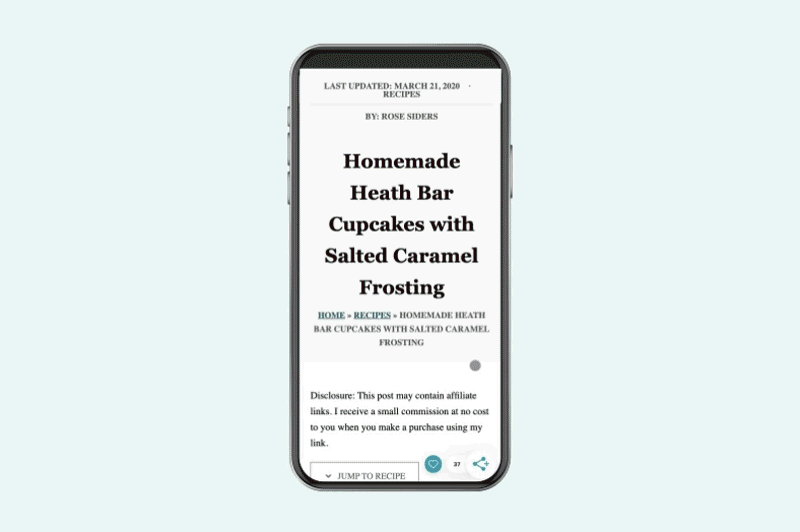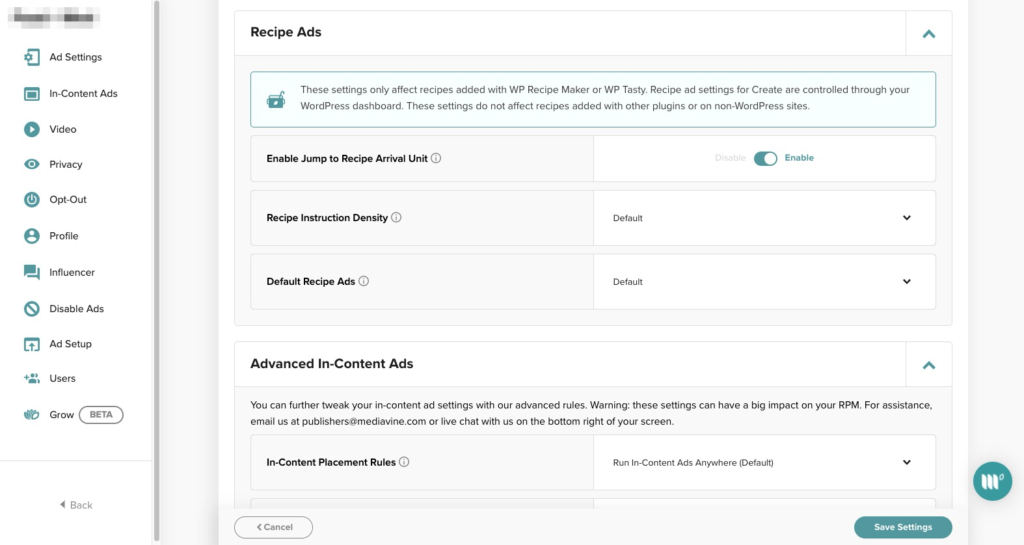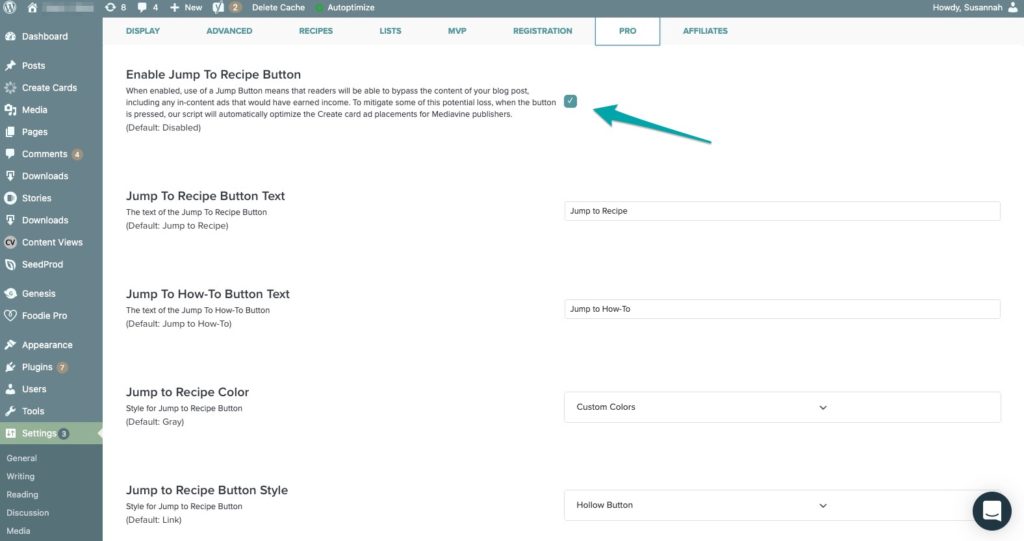- Ad Settings
Jump to Recipe: How it Impacts Revenue … For the Better!
•
Bloggers are no stranger to the Jump to Recipe button, or as we sometimes call it to encompass more than just recipes, the Jump to Card button.
If you’re a food or how-to blogger, you’re likely familiar with the dilemma:
Writing more content before the How-To or Recipe Card improves RPM and SEO but often results in complaints from users who want to bypass the content and jump straight to the recipe.
The Jump to Recipe function has undoubtedly offered a great balance for those readers who wish to get straight to the meat of the post, but what many don’t recognize is that for publishers, that content can be their livelihood.
In other words, giving up revenue is not a decision to take lightly. But how much are you really giving up with a Jump to Recipe button? And is it worthwhile for better reader engagement?
Today, we’ll break down the actual impact of the Jump to Recipe or Jump to Card button (abbreviated as JTR from here on out) on your bottom line, now and down the road.
Important Caveat: This post only applies to publishers using Mediavine-exclusive ad optimizations and supported recipe cards: Create, WP Tasty or WP Recipe Maker. (Other ad management companies and cards will likely experience very different results.)
With that disclaimer, let’s get into it!
Jump to Recipe Basics: What Happens When Someone Clicks?
Historically, when clicking on the JTR button, a web user skipped past all content and ads and arrived at the recipe card.
This meant many ads loading which were never seen by the user, crippling a site’s viewability, ad performance, reputation among the ad exchanges and eventually, long-term earning potential.
Enter exclusive Mediavine Recipe Ad Technology.
The old days are long gone. Now when a user clicks the JTR button, they still skip the content, but thanks to our exclusive lazy loading ad technology, the skipped ads won’t load.
This seemingly small distinction is critically important.
Lazy loading preserves your website’s viewability and its performance with advertisers, and with that, its long-term earning potential.
As for the short-term revenue lost by readers skipping ads? Well, we actually now offer a few solutions to this problem as well.
One of these is our exclusive Arrival Unit, an ad that readers are taken to just before arriving at the recipe card. Enabling this unit gives you a highly viewable ad with great engagement.
Combine the Arrival Unit with Mediavine’s ability to run multiple recipe card ad units and you can mitigate any short-term revenue loss!

Okay, But What’s the Actual Impact on the Bottom Line?
Fine, enough abstract talk. Put down all beverages and make sure you’re sitting down.
We’ve found that publishers running all of these recipe optimizations actually make up to 15 percent more revenue when a user clicks the JTR button!
You’re welcome — for the revenue, and for telling you to put down the coffee a second ago. No need to spend that extra 15 percent on a new laptop!
Wow, How is That Possible?
All kidding aside, put yourself in the shoes of a reader jumping to the recipe. They’re likely either trying to cook the recipe right now or shopping for the ingredients.
They might be skipping the content beforehand, but either of these time-consuming tasks likely means that the reader is heavily engaged inside the recipe card.
Your audience is locked in, and ads inside the recipe card are eligible to refresh if the user spends enough time on that page.
When you factor in the Arrival Unit and additional recipe card ad impressions, these power users are actually seeing more ads than readers who didn’t go the JTR route and ended up bouncing out of the website altogether before even making it to the card.

So Does JTR Make Me More Money?
Not necessarily. Correlation does not always equal causation, as they say in statistics.
In this case, looking at the users who jumped to the recipe may just be looking at your most engaged users.
What would those users have done if there was no jump available? Would they have scrolled to the recipe card and spent just as much time there? It’s hard to give a generic, catch-all answer.
However, our findings from studying websites that enable JTR is that there is little to no impact on revenue.
What we typically see is a decrease in in-content ad earnings balanced out by an increase in recipe ad earnings. In the end, the impact on short term earnings is negligible.
And again, thanks to our lazy loading ads, we see almost no impact on viewability by enabling this button.
Should I Offer Readers a Jump to Recipe button?
If you’re prepared to enable the other Mediavine Recipe ad optimizations, including the Arrival Unit discussed above, then absolutely.
JTR will have little to no impact on your website’s revenue, and users looking for this feature will be very happy you added it.

What About Accessibility?
If you’re worried about website accessibility for visually impaired readers (something you should take seriously, as we’ve discussed at length), we recommend you update to the latest version of Create, which includes Skip to Recipe and Skip to Instructions — this will provide a screen reader, or accessibility version, of the Jump to Recipe button.
If you’re running a different card, we recommend you implement this feature yourself on your website to address accessibility.
Will JTR Help with SEO?
Despite rumors to the contrary, you will not see any direct improvements to SEO rankings just by enabling a Jump to Recipe button.
However, you may see some indirect SEO benefits.
By creating a better user experience, you may end up with readers who are more likely to share or link to your content, indirectly benefitting your SEO.
What About Table of Contents and Other Jump-Style Links?
Our lazy loading ad technology will still prevent in-content ads from loading with table of contents plugins or other jump-type links that are not recipe cards, solving for the long-term revenue impacts of viewability loss.
However, without the recipe card portion and features like the Arrival Unit, you won’t get the short-term benefit of engaged readers earning you more in this scenario.
Bottom line? Implementing other buttons such as these will likely entail a small impact to revenue, so you’ll have to weigh those separately from JTR.
We can only solve so much of the Internet at a time.
JTR and You: Making the Right Decision
Only you can decide what’s most important when it comes to decisions like JTR. Our job is to present publishers with the best array of options to build sustainable businesses.
To the six of you who made it this far, we hope we presented a compelling case for its benefits while dispelling some of the rumors that might be holding you back.
At the end of the day, we believe we’ve improved publisher and reader experiences alike and solved for a lot of issues that might have made JTR a major liability just a few years ago.
About the author
Share this page